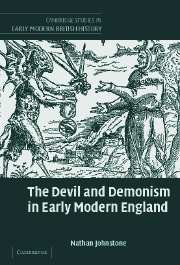Book contents
- Frontmatter
- Contents
- Acknowledgements
- 1 Introduction
- 2 The synagogue of Satan: anti-Catholicism, false doctrine and the construction of contrariety
- 3 Temptation: the Protestant dynamic of diabolic agency and the resurgence of clerical mediation
- 4 Satan and the godly in early modern England
- 5 Incarnate devils: crime narratives, demonisation and audience empathy
- 6 ‘What concord hath Christ with Belial?’: de facto satanism and the temptation of the body politic, 1570–1640
- 7 ‘Grand Pluto's Progress through Great Britaine’: the Civil War and the zenith of satanic politics
- 8 ‘The Devil's Alpha and Omega’: temptation at the cutting edge of faith in the Civil War and the Interregnum
- Conclusion
- Bibliography
- Index
- Cambridge Studies in Early Modern British History
8 - ‘The Devil's Alpha and Omega’: temptation at the cutting edge of faith in the Civil War and the Interregnum
Published online by Cambridge University Press: 23 June 2009
- Frontmatter
- Contents
- Acknowledgements
- 1 Introduction
- 2 The synagogue of Satan: anti-Catholicism, false doctrine and the construction of contrariety
- 3 Temptation: the Protestant dynamic of diabolic agency and the resurgence of clerical mediation
- 4 Satan and the godly in early modern England
- 5 Incarnate devils: crime narratives, demonisation and audience empathy
- 6 ‘What concord hath Christ with Belial?’: de facto satanism and the temptation of the body politic, 1570–1640
- 7 ‘Grand Pluto's Progress through Great Britaine’: the Civil War and the zenith of satanic politics
- 8 ‘The Devil's Alpha and Omega’: temptation at the cutting edge of faith in the Civil War and the Interregnum
- Conclusion
- Bibliography
- Index
- Cambridge Studies in Early Modern British History
Summary
We have seen the place the Devil occupied in the discourse of the opposing sides in the English Civil War, in which demonism provided a means of engaging with the complexities of the struggle. In this final chapter we will examine the role of demonism in the godly's attempts to reform the church after the calling of the Long Parliament. The controversies that soon punctured the anti-Laudians' reforming zeal are of course well documented, but the significance of accusations of diabolism between the godly themselves has been neglected. Historians of the Presbyterian/Independent controversies have had little to say concerning the demonic context of the dispute. Yet demonism permeated the issue precisely because the godly sought what they self-consciously identified as a reformation. Reform, understood through the history of Protestantism, was an inherently anti-demonic act. Its success would be measured, in part at least, by the eradication of demonic influence within the commonwealth, in terms of both politics and personal devotion. As an anti-demonic process, reformation could also be expected to be prey to a concerted campaign of diabolic subversion. Protestants had long taken to heart the convention that Satan reserved his greatest assaults for the most godly, and this understanding was extended to the process of reformation itself. It was precisely because a reformation might involve a break with the familiar and an exploration of new practices, and indeed new religious experiences, that this cutting edge of faith was perceived as an inherently dangerous place.
- Type
- Chapter
- Information
- The Devil and Demonism in Early Modern England , pp. 250 - 285Publisher: Cambridge University PressPrint publication year: 2006



